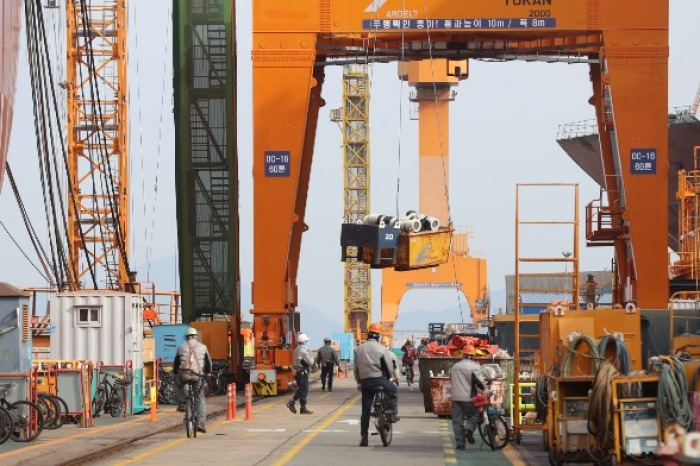Shipping & Shipbuilding
S.Korea's shipbuilding order volume to plummet next year: report
A worsening global financial climate marked by surging interest rates could cause order volume to drop by over 40%
By Nov 07, 2022 (Gmt+09:00)
1
Min read
Most Read
LG Chem to sell water filter business to Glenwood PE for $692 million


Kyobo Life poised to buy Japan’s SBI Group-owned savings bank


KT&G eyes overseas M&A after rejecting activist fund's offer


StockX in merger talks with Naver’s online reseller Kream


Mirae Asset to be named Korea Post’s core real estate fund operator



South Korea's shipbuilders fear seeing their orders next year plummet by over 40% on-year due to disruptions in related financing amid surging interest rates fueled by a global economic downturn.
The Overseas Economic Research Institute, an arm of the Korean Export-Import Bank released a report Monday on the global shipbuilding sector in the third quarter and its outlook for 2023. For domestic shipbuilders, the order forecast was 8.5 million compensated gross tonnage (CGT) next year.
That would be a drop of 41.8% from this year's estimated output of 14.6 million CGT, and worth an estimated $22 billion — an amount 42.9% less than this year's estimated $38.5 billion.
The gloomy projections stem from the deteriorating global shipbuilding market. Global demand is forecast to fall 37.1% on-year from an estimated 35 million CGT this year to 22 million CGT, with the valued amount plummeting 39% from $100 billion this year to $61 billion next year.
In addition to sluggish demand, another key culprit is the worsening financial climate amid surging interest rates worldwide. Except for liquefied natural gas (LNG) carriers and container vessels, both of which are seeing demand take off, large-scale investment in bulk ships and tankers is not expected amid the poor business environment.
The institute also cited domestic shipbuilders' focus on the LNG and container types as a problem. Through the third quarter this year, LNG vessels accounted for 64.6% of domestic orders and container vessels 30.9%, meaning that 95.5% of the nation's shipbuilding is concentrated in these two types alone.
More labor is needed to build LNG and container vessels than other types of ships, but in view of a growing risk of strikes amid a severe industry labor shortage, fears are rising that the heavy reliance on those two types will emerge as a major detriment for the sector.
Yet the shipbuilding slump is expected to be temporary with recovery foreseen beginning in 2024. With the adoption in January of marine environment regulations such as the Energy Efficiency Existing Ship Index and carbon intensity indicator, demand for eco-friendly vessels and the replacement of aging ones are expected to grow.
Write to Seo-woo Jang at suwu@hankyung.com
More to Read
-
 Shipping & ShipbuildingS.Korea to widen tech gap with global shipbuilding rivals
Shipping & ShipbuildingS.Korea to widen tech gap with global shipbuilding rivalsOct 20, 2022 (Gmt+09:00)
2 Min read -
 Shipping & ShipbuildingKSOE in $1.5 billion shipbuilding deals with Maersk, Excelerate Energy
Shipping & ShipbuildingKSOE in $1.5 billion shipbuilding deals with Maersk, Excelerate EnergyOct 05, 2022 (Gmt+09:00)
2 Min read -
 Mergers & AcquisitionsHanwha agrees to buy Daewoo Shipbuilding for $1.4 billion
Mergers & AcquisitionsHanwha agrees to buy Daewoo Shipbuilding for $1.4 billionSep 26, 2022 (Gmt+09:00)
3 Min read
Comment 0
LOG IN


